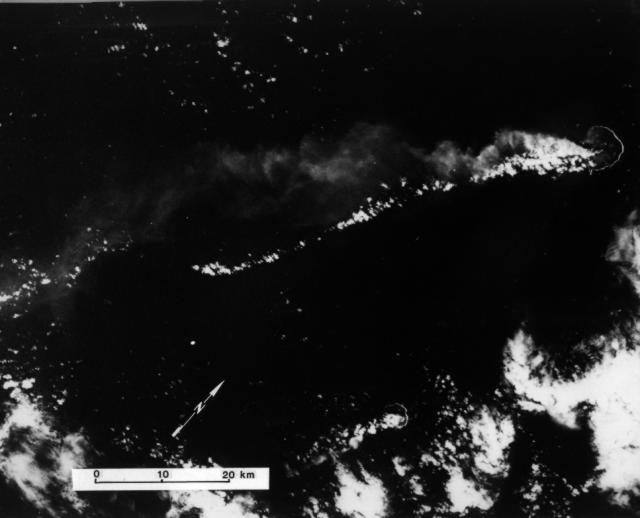Report on Pagan (United States) — April 1985
Scientific Event Alert Network Bulletin, vol. 10, no. 4 (April 1985)
Managing Editor: Lindsay McClelland.
Pagan (United States) Plumes and new lava flow
Please cite this report as:
Global Volcanism Program, 1985. Report on Pagan (United States) (McClelland, L., ed.). Scientific Event Alert Network Bulletin, 10:4. Smithsonian Institution. https://doi.org/10.5479/si.GVP.SEAN198504-284170
Pagan
United States
18.13°N, 145.8°E; summit elev. 570 m
All times are local (unless otherwise noted)
The crew of a Continental Air Micronesia flight that passed about 25 km W of Pagan at about 6 km altitude on 11 April at 0840 observed a large brown ash cloud obscuring the volcano. The eruption column rose to about 2.5 km altitude and a plume extended about 150 km to the W. On 15 April at 1400, another Continental Air Micronesia flight passed over Pagan and the crew reported a new lava flow. Information on its size and position were not available.
On 1 May at about 1000, Space Shuttle astronauts took nine photographs that showed a plume originating from near the center of the volcano and extending at least [100] km to the SSW (figure 2). The plume was dense near the volcano and appeared to contain some ash, but diffused rapidly as distance from Pagan increased. Weather clouds obscured the volcano during subsequent orbits.
Geological Summary. Pagan Island, the largest and one of the most active of the Mariana Islands volcanoes, consists of two stratovolcanoes connected by a narrow isthmus. Both North and South Pagan stratovolcanoes were constructed within calderas, 7 and 4 km in diameter, respectively. North Pagan at the NE end of the island rises above the flat floor of the northern caldera, which may have formed less than 1,000 years ago. South Pagan is a stratovolcano with an elongated summit containing four distinct craters. Almost all of the recorded eruptions, which date back to the 17th century, have originated from North Pagan. The largest eruption during historical time took place in 1981 and prompted the evacuation of the sparsely populated island.
Information Contacts: N. Banks, HVO; R. D. Morris, Continental Air Micronesia, Guam; W. Dailey and C. Wood, NASA, Houston, TX.


